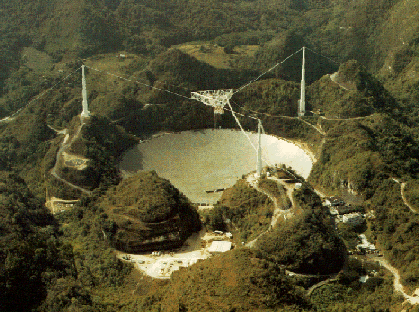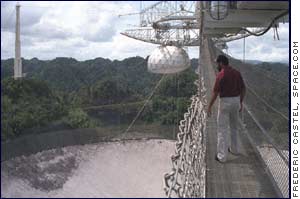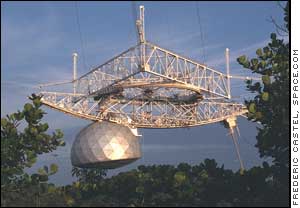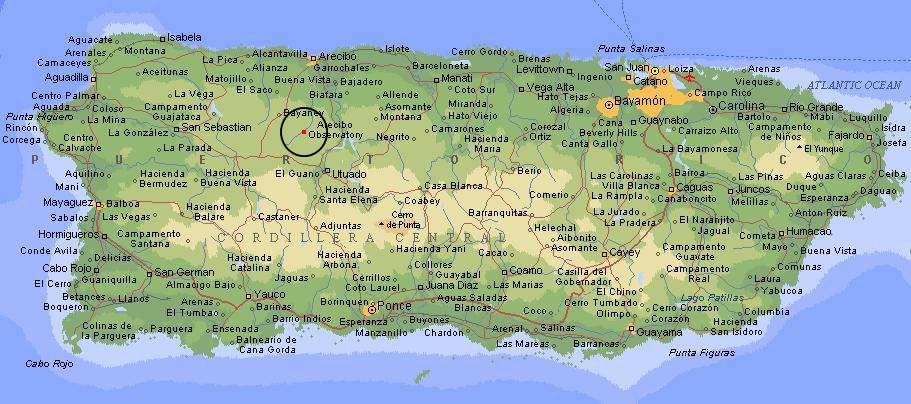TARGET 070110

The World's Largest Telescope
Arecibo: Celestial Eavesdropper
Exerpted from a report provided to Space.com
By Frederic Castel
|
ARECIBO, Puerto Rico -- It is a space-age sentinel, rising out of the
prehistoric jungles of Puerto Rico -- a 1,000-foot (305-meter)
diameter aluminum "ear," cocked perpendicular to Earth, leaning
into the sky, listening.
For 37 years radio astronomers at the Arecibo Observatory have used
this, the world's largest radio telescope, to fathom the radio
signals of the cosmos. It has tuned in on the tumultuous songs
buried in the hearts of stars and quasars that radiate from the
very edge of the universe. Closer to home, it has lent an ear to
random radio emissions emanating from 2 miles (3.2 kilometers)
within the upper atmosphere.
Located 12 miles (19 kilometers) from the coastal city of Arecibo,
the facility requires a full-time staff of 140. Most of them are
technicians and engineers, and nearly 30 are astronomers and
engineers from countries as different as India, Uruguay, Great
Britain, Sweden, Belgium and United States.
|

|
Using the catwalk, Reinaldo Velez, chief telescope technical
operator, reaches the 900-ton reflector suspended 450 feet
(137 meters) above the radio telescope.
|

|
"The radio telescope can be used 24 hours a day," says Reinaldo
Velez, the observatory's chief telescope technical operator.
"Darkness or daylight doesn't make any difference when it comes
to radio waves."
Even so, most scientists prefer to work at night, Velez says,
as the interference from cell phones, pagers and radar is much
less.
With the proliferation of modern electronic devices and
communications equipment, electronic interference has
grown worse in recent years. Besides Earth-based technology,
communication-satellite constellations like those of the now
defunct Iridium, along with powerful military and civilian
airport radar also clutter the radio waves.
"It's similar to optical telescopes having to penetrate city
air pollution," says Velez, who has been at the observatory
26 years. "It's a constant battle we cannot win."
However, the assault on Arecibo comes on two fronts -- while
electronic emissions encroach from the air, on the ground of
this former 15th-century Spanish colony in the Caribbean, the
tropical forest forever attempts to consume the structure.
"Sometimes, up to three days a week, the radio telescope is
shut down because technicians have essentially to beat back
the jungle," says Mike Nolan, a planetary radar scientist.
Most of the engineers compare the facility to a ship exposed
to natural marine threats: tropical heat, luxuriant vegetation,
fungi and salty air all can create rust and other harsh effects
on the fine electronics and complex mechanisms. The observatory's
smooth operations depend on 26 electrical motors and 30 miles
(48 kilometers) of thick cables supporting the 900-ton reflector
suspended 450 feet (137 meters) above the radio telescope's metallic
dish.
Even under the observatory's spherical dish, 1,000 feet in
diameter (305 meters) and suspended from 20-foot- (6-meter-)
long cables, an abundant and colorful life flourishes. While
deterring erosion of the limestone terrain, a lush growth of
ferns, begonias and wild orchids have to be trimmed on a regular
basis to keep them from interfering with the 18-acre surface of
the bowl-shaped reflector. Composed of 40,000 aluminum panels,
this antenna covers the same area as 26 football fields.
|
Unmatched after 44 years
|
With constant technical upgrades, the Arecibo observatory, built
in 1963, remains the largest curved focusing antenna on the
planet. By definition, that distinction also makes it the world's
most sensitive radio telescope. A larger size means a larger
collecting area, which permits the detection of radio-emitting
cosmic objects too faint to be picked up by smaller facilities.
The observatory has been constantly upgraded over the years.
In 1997, a $25 million Gregorian reflector was installed 450
feet (137 meters) over the dish, a major renovation. This
state-of-the-art feed system uses two mirrors to focus the
radio-wave energy to a point. This reflector system is still
being fine-tuned to operate over a large frequency range,
allowing the radio telescope to work at higher frequencies --
from 50 megahertz (6-meter wavelength) up to 10,000 megahertz
(3-centimeter wavelength).
"With access to a wider range of frequencies, you can reach
very interesting and new sets of molecules different than
hydrogen, which is routinely studied," says Daniel Altschuler,
director of the observatory.
The observatory officially opened November 1, 1963 and cost $9
million. If built today, Arecibo would cost in excess of $100
million. Although its entrance is guarded, the observatory has
never classified any information. The observatory has a relaxed
atmosphere, reminiscent of the era in which it was first
conceived and constructed, the 1960s.
The site is so impressive that movie stars and Hollywood producers
have used the observatory in various films, most recently in Contact,
the film adaptation of the Carl Sagan bestseller that starred Jodie
Foster. It was also the setting of the finale of Pierce Brosnan's
first James Bond flick Golden Eye.
But Arecibo is first and foremost the cradle of scientific discoveries
that have changed our vision of the universe. It is the only
national observatory in the world to have fostered work resulting
in a Nobel prize in physics.
|

|
The 1,000-foot-diameter dish is suspended -- from 20-foot-long
cables -- over luxuriant tropical vegetation.
"This is probably the most important scientific heritage. Thanks
to data collected for the first time in 1974 and exclusively at
Arecibo's, the Einstein's gravitational-wave theory has been
confirmed by Joseph Taylor and Russell Hulse," says Altschuler.
"The two astrophysicists were awarded the 1993 Nobel Prize for
their discoveries predicted by Einstein's general theory of
relativity."
As Joseph Taylor and Russell Hulse were observing the radio
pulses of a pulsar, a mysterious difference in the arrival
times of pulsed radio waves made them realize they had found
a binary pulsar. Pulsars are rapidly rotating stars that
collapse after consuming their nuclear fuel. Their resulting
emissions of strong, pulsed radio waves are due to the spinning
of the remaining star.
In a binary system, the two pulsars are tied to each other in
a "dance of death", as their relative motion has them spiraling
toward one another, toward an unavoidable cataclysmic collision.
This "dance of death" results from the fact that the acceleration
of massive objects generates gravitational waves as predicted by
Einstein's theory.
In 1991, astronomers at Arecibo discovered the first extrasolar
planetary system. Three planets were identified orbiting the
rapidly rotating pulsar B 1257+12.
This breakthrough in planetary science - showing that planets can
form around these volatile stars - has been confirmed by the
growing number of planetary system discoveries made by different
observatories around the world.
|
Radio Astronomy and Radar Astronomy
|
About 80 percent of the operating time at Arecibo observatory is
spent on radio astronomy, where the antenna simply receives signals
emitted by stars and other astronomical bodies. Radar astronomy,
where a signal is sent out from the antenna and bounces back,
represents only 5 percent, with atmospheric studies taking up the
remaining 15 percent of the time.
When the huge telescope switches to a radar mode, it beams out a 1
million-watt power signal toward planets, moons, asteroids, comets
and planetary rings. The minute echo of the signal on the astronomical
target, which is collected by the huge dish and then amplified, allows
scientists to create -- like a scanner -- images and maps of the
surface of the object.
Although the cost of emitting signals from Arecibo is high (you
need a 2 million-watt emission to get effectively 1 million watts of
power), radar astronomy has been very productive. As early as 1964,
using the telescope's planetary radar capabilities, astronomers were
able to measure for the first time the rotation of Mercury.
With an accuracy of a few hundred feet, Arecibo radar observations
have helped NASA to pick up the best sites for Apollo moon landings
and for the Viking landings on Mars.
"Arecibo radar range is so good that we can study asteroids and comets
that speed around our solar system with a resolution of 15 meters
(50 feet)," says Jean-Luc Margot, a Belgian expert in radar astronomy.
Should an asteroid be suspected of having an Earth-threatening path,
Arecibo (and Goldstone) observations would be vital to determining
its precise trajectory. If a collision trajectory should be confirmed,
additional radar data would be needed to further refine the location
of the dangerous asteroid.
"It's amazing that radar astronomy gets a much smaller budget than a
Hollywood production about asteroids and their catastrophic effects,"
says Margot who doesn't consider an Armageddon-style movie to be
accurate.
|
An advanced research project agency program
|
Radio astronomy was born early in the 20th century when scientists
tried to understand why hiss-like static was constantly plaguing
their first transatlantic radio transmissions.
In the early 1930's, Karl Jansky, a young physicist at Bell Labs,
discovered that some of the radio waves generating the static
interference were emanating in fact from the center of the Milky
Way. But the cosmic signals were so weak that it took decades
before huge radio telescopes could be built to capture and
decipher radio-wave signals coming from space.
The Arecibo radar telescope was the idea of William E. Gordon,
professor of electrical engineering at Cornell University. His
original idea was to study the upper layers of Earth's upper
atmosphere -- the ionosphere -- located above 30 miles (48
kilometers) high. That's why the Arecibo Observatory was
initially called the Arecibo Ionospheric Observatory (AIO), and
only years later it was renamed the National Astronomy and
Ionosphere Center, or NAIC.
Understanding the physics of the ionosphere had more than purely
scientific interest since the atmospheric layers are the natural
environment used for long-distance communication by bouncing radio
waves. Even more, in the middle of the Cold War, the space race
was raging.
At first, the United States Department of Defense was mildly
interested in this project, however it became involved when it
was pointed out that the observatory would be able to detect the
trails of ionization created by Russian rockets going into orbit.
Funded by the Advanced Research Project Agency (ARPA), the Arecibo's
radar/radio observatory was built in three years by Cornell
University under contract with the Air Force Cambridge Research
Laboratory. It was conceived from the calculations of William Gordon,
but the 1000-foot dish made it impossible to use moving radio and
radar antennas.
Natural sinkholes dug by water in the limestone soil of Puerto Rico
provided an economical solution with a natural geometry to support
the huge spherical reflector. A movable receiver hanging above the
reflector was the best way to give the observatory the capability
of covering a 38-degree wide band of the sky. Puerto Rico's
equatorial position (18 degrees from the equator) offered the extra
advantage of targeting the overhead sun, moon and planets.
Arecibo Observatory is operated by Cornell University in cooperation
with the National Science Foundation (NSF) which provides most of
its $10 million annual budget. NASA's Planetary Studies program
provides 6 percent of that budget.
"The budget is tight, and we have to make difficult choices to reach
our goals," Altschuler says.
|
The search for life beyond Earth
requires strong assumptions
|
Each year, about 20 days of research are dedicated to the Search
for ExtraterrestriaI Intelligence (SETI) program called Phoenix.
Using computer hardware specifically dedicated to their work, the
SETI team comes periodically to select stars much like the Earth's
sun and analyze signals they believe may be artificial.
"To us it's like any other science proposal," says Altschuler, who
is not optimistic about the SETI team's chances of getting an
interesting signal.
"SETI people assume [that an extraterrestrial] evolution of 4 billion
years similar to ours leads to a communication technology that we
can pick up. That is a very strong assumption," Altschuler says.
"But on the other hand if we do not search, we will never know if
[anything] is present. So it stands to reason that a certain
fraction of the effort be geared at doing the experiment."
|
FEEDBACK MAP

|
If you got impressions for which this feedback is
insufficient, please take a look at the following web sites
for more:





